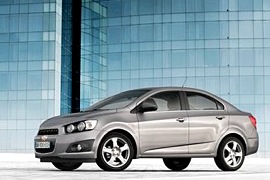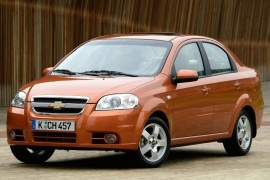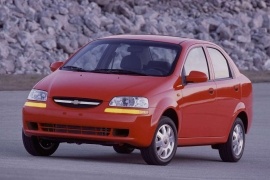CHEVROLET Aveo / Kalos Sedan Models/Series Timeline, Specifications & Photos
First production year: 2004
Engines: Gasoline, Diesel
The small sedan from Chevrolet was the last try of the American brand to conquer Europe. It represents the farewell to the old Daewoo platform and, in 2011, with a new design, the Aveo meant business.
The sedan version was a good offer for the East European market, where three-box vehicles are preferred. The budget cars were blooming and the economy was recovering after the world financial crisis. The four-door saloon was offering decent features and decent room for five adults and a separate trunk. The 2011 Aveo didn't have anything in common with the older one. More aggressive styling was adopted and, on the upper trim levels, it offered light-alloy-wheels.
The engine range was ranging from a small, gasoline, fuel-efficient 1.2-liter unit that offered 75 hp or 86 hp, respectively. The top gasoline version was a 1.6-liter that offered 115 hp, which was not bad for a light small car. A 1.3-liter turbo-diesel version was available with two power options.
The interior materials were according to its class and price budget. Standard options were the AC, central locking and a stereo. The trunk was huge, with its 502 liters (17.7 cu-ft). The option list was generous, and an automatic transmission was available too.
But the car didn't survive the market. It was too expensive as a base model and, with more options, had a sticker price higher than its competition.
GM introduced an ample facelift for the Aveo lineup in 2005 and offered it as a three- and five-door hatchback or a four-door sedan.
In 2005, Europe switched to Euro4 standards, and most carmakers had to adapt quickly. Unlike the former set of mandatory engine emissions requirements, this one also imposed a few safety systems. Thus, Chevrolet had to pour some money and make the transition from the T200 to the T250 version of the car.
Strangely, the Aveo Sedan didn't share its front fascia with its hatchback siblings. Instead, it featured conventional-looking headlights with a bland design, a reminiscence from the bio-design era. Between them, split between the hood and the front bumper, was the grille that sported a horizontal slat where the bow-tie badge was installed. Depending on the trim level, Chevrolet also added a pair of fog lamps on the lower side of the wrapped-around bumper. From its profile, on the other hand, it didn't look like a hatchback with an extended trunk in the back. It looked like it was designed like that from the start. And that was a good thing. Still, to lower the manufacturing costs, the rear fascia was fitted with corner-mounted taillights.
Inside, the materials looked rather mundane. Its cloth upholstery and hard plastic areas were not very appreciated by customers, but they were inexpensive. The dashboard featured a small instrument cluster where plastic pieces tried to mimic aluminum. At the back, the narrow bench was mostly suitable for two children, and the headroom wasn't that generous.
GM offered the car with a choice of four engines, depending on the market. Some versions were also fitted with a four-speed automatic transmission.
CHEVROLET Aveo/Kalos Sedan 1.2L 5MT FWD (72 HP)
CHEVROLET Aveo/Kalos Sedan 1.2L 5MT FWD (84 HP)
CHEVROLET Aveo/Kalos Sedan 1.4 5MT FWD (94 HP)
CHEVROLET Aveo/Kalos Sedan 1.4L 4AT FWD (101 HP)
CHEVROLET Aveo/Kalos Sedan 1.4L 4AT FWD (94 HP)
CHEVROLET Aveo/Kalos Sedan 1.4L 5MT FWD (101 HP)
After purchasing the Daewoo remains, GM found a pile of blueprints and plans for several cars, including a small-segment vehicle, the Aveo/Kalos.
Chevrolet needed a low-budged vehicle, required not only by car-rental companies but also by private customers. The Aveo came in the right moment at the right time, at least for some countries. In the U.S., the small sedan was good in heavy traffic, had an impressive fuel efficiency, and the performance of a donkey in full rage.
TheAveo's rounded shapes, with straight lines for the front turn signals and headlights, showed a mix between a bio-design and a new-edge-design concept. The smiling grille sported a horizontal slat where Chevrolet placed the bow-tie badge small enough to be almost unnoticeable. A sculptured line went down on the door panels on the sides, while in the back, the tall trunk looked like it was added after the hatchback was already built. And that's exactly what happened since the original design was for the five-door hatchback, not for the sedan.
Inside, the Aveo was built with low-budget materials. It featured cranked windows and no AC nor stereo for the base trim level. Usually, the customers bought the more expensive versions. At the front, the tall seating position made the taller driver brush their hair with the car's ceiling, while the rear passengers had minimal legroom, shoulder room, elbow room, or headroom. At least the trunk was big enough to fit four medium-sized luggage inside it.
Under the hood, Chevrolet installed a range of six engines, depending on the market. It offered a five-speed manual transmission for the entire range.


